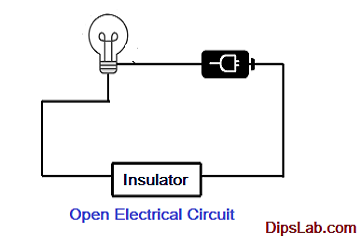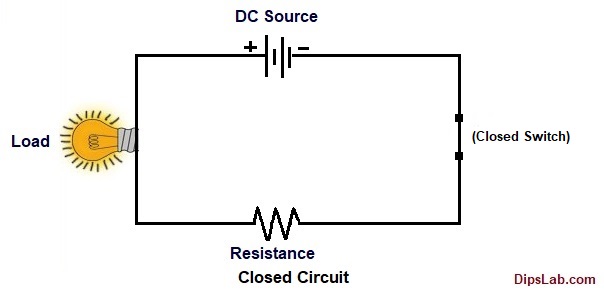If any components disconnect or break from the circuit, this circuit works as the open circuit. Sometimes, the open circuit shows like OFF condition or fault condition.
Example of Open Circuit:
Suppose, we have connected the DC supply battery with the connected bulb as load, resistance, and switch.
When the switch is open, the electric current does not flow from the source (battery) to the desired load (light).

Thus, this circuit does not conduct the electricity and zero potential difference occurs between two terminals of the open switch due to the incomplete path.
In another case, when we connect insulators or insulating devices in an electric circuit, electricity does not flow even though the circuit path is complete.
Given below is the diagram with connecting source, load, and insulator.

Due to the insulator, the current does not pass in a circuit, and light does not glow.
It means that, sometimes, an insulator works as an open circuit.
What is Closed Circuit?
In a closed circuit, the electric current (charged particles) flows from an active energy source to the connected load or other components due to the closed-loop path.
For the closed circuit, we require
- conducting materials or conductor (like copper) path
- the active voltage source device (like a battery)
- complete path or circuit to flow the electric current
Example of Closed Circuit:
Suppose, the DC voltage supply battery is connected with the light (like load) and closed switch. Due to the closed switch, the circuit makes the complete path to the flow electric current.

From the above diagram, you can see the bulb is glowing in the closed circuit.
Thus, this circuit does not conduct the electricity and zero potential difference occurs between two terminals of the open switch due to the incomplete path.
In another case, when we connect insulators or insulating devices in an electric circuit, electricity does not flow even though the circuit path is complete.
Given below is the diagram with connecting source, load, and insulator.

Due to the insulator, the current does not pass in a circuit, and light does not glow.
It means that, sometimes, an insulator works as an open circuit.
What is Closed Circuit?
In a closed circuit, the electric current (charged particles) flows from an active energy source to the connected load or other components due to the closed-loop path.
For the closed circuit, we require
- conducting materials or conductor (like copper) path
- the active voltage source device (like a battery)
- complete path or circuit to flow the electric current
Example of Closed Circuit:
Suppose, the DC voltage supply battery is connected with the light (like load) and closed switch. Due to the closed switch, the circuit makes the complete path to the flow electric current.

From the above diagram, you can see the bulb is glowing in the closed circuit.
One Response